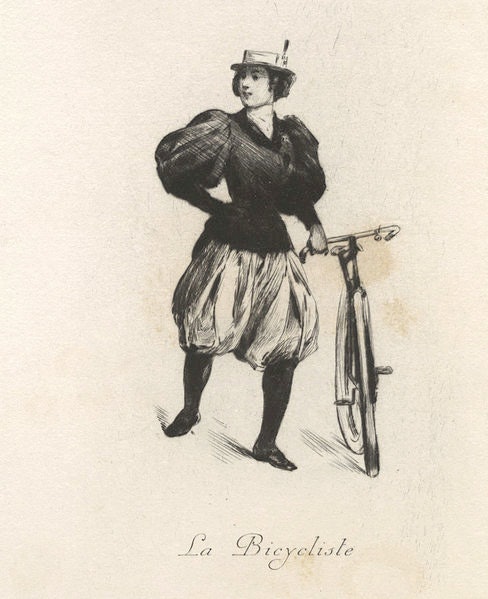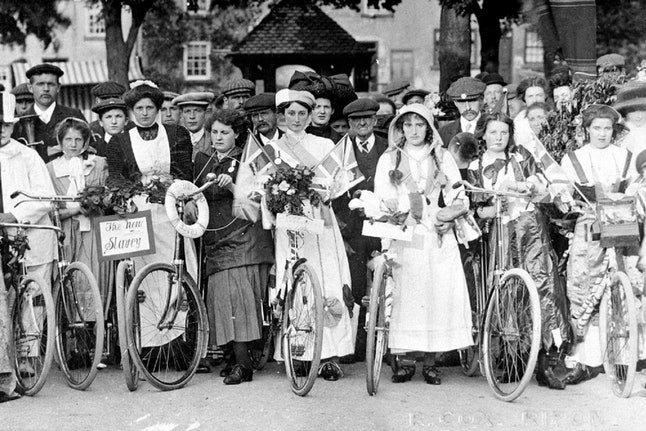
International Women’s Day: The bicycle – a Feminist Partner
8 March, or how and why the International Women’s Day became an unavoidable ‘’rendez-vous”. In a world still marked by inequality, let’s take a moment to celebrate women’s achievements, to raise awareness on biases and gender-gaps and to pay tribute to women’s past and current accomplishments. Throughout the decades, many women have stood for their rights and run for more equality or, should we say…cycled?
A symbol of emancipation
 The bicycle and the International Women’s Day: is this such an unexpected combination? In the 1860s the “velocipede” appeared on the European market, revolutionising everyday’s trips. As it was rather expensive at the time, only women from the high society could try this innovation, a symbol of elegance and modernity. This burgeoning love between women and the velocipede was not of the taste of everyone and quickly became poorly looked upon by men. Suddenly, many concerns regarding the use of the velocipede started being raised, in the name of the preservation and protection of women. Some found this activity immoral, doctors published scientific theories about cycling’s role in sterility, in causing ulcers, illnesses and other inflammations. Others feared that cycling would distract women from their conjugal duties. But despite everything, women were determined to keep riding.
The bicycle and the International Women’s Day: is this such an unexpected combination? In the 1860s the “velocipede” appeared on the European market, revolutionising everyday’s trips. As it was rather expensive at the time, only women from the high society could try this innovation, a symbol of elegance and modernity. This burgeoning love between women and the velocipede was not of the taste of everyone and quickly became poorly looked upon by men. Suddenly, many concerns regarding the use of the velocipede started being raised, in the name of the preservation and protection of women. Some found this activity immoral, doctors published scientific theories about cycling’s role in sterility, in causing ulcers, illnesses and other inflammations. Others feared that cycling would distract women from their conjugal duties. But despite everything, women were determined to keep riding.
From the 1880s, the bicycle became more affordable and accessible, but the clothes women were wearing were incompatible with the practice of cycling. Slowly but surely, corsets and dresses started being replaced with “bloomers”, the ancestors of trousers.
'The Freedom Machine'
On a bicycle, women were alone, free from men and to decide by themselves where to go. For the first time, they could choose their path and destination. In 1894, Annie Londonderry took up a challenge by cycling around the world to question perceptions of femininity. And it worked. She opened the path to independence. The bicycle helped women to distance themselves a little from their husband and house, and to assert their part of freedom, decision-making and emancipation. A symbol of this empowerment, the bicycle soon became the perfect tool in the search for freedom.
The late 19th century was marked by the spread of the bicycle, in parallel to the movements across Europe and the United States for women’s equality. Both movements naturally found their way towards each other, as women on bicycles became the symbol of the modern and new woman. Pure instrument of liberation, the bicycle was soon adopted by suffragettes running (biking) for the elections. A major figure of the women’s rights, Susan B. Anthony herself declared in 1896 that the bicycle “has done more to emancipate women than any one thing in the world and […] I rejoices every time I see a woman ride by on a bike." More concretely, women drew attention by riding around on bicycles with the “Vote For Women” banners in the 1910s, among other campaigns.

Where do we stand today?
For many of us, cycling is very common and seems to be done by women as much as by men. Reality is that a gender-gap still exists. Research shows that women more than men value better and safer cycling infrastructure. Catering for their needs would highly contribute to make cycling more accessible and attractive to women – as well as to the entire society. Moreover, in certain countries, cycling is still forbidden or authorized only when women are accompanied by a man.
Today, as we are celebrating the International Women’s Day, we would like to recall how much the bicycle has contributed to women’s emancipation throughout the decades and to stress that much still remains to be done.
Topics:
Contact the author
Recent news!
Contact Us
Avenue des Arts, 7-8
Postal address: Rue de la Charité, 22
1210 Brussels, Belgium









